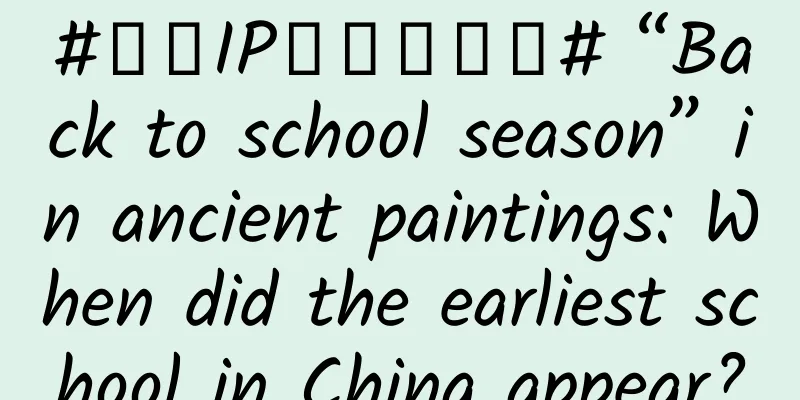#千万IP创科学热门# “Back to school season” in ancient paintings: When did the earliest school in China appear?

|
Do you know when the earliest schools in China appeared? Were they also called "schools" at that time? Let's take a look at the "school season" of the ancients and explore how their study process is different from our modern one. Ancient people's "school records" China has a very long history of education. As early as the Xia Dynasty, there were formal schools that focused on teaching, called "schools". "Mencius: Teng Wengong Shang": "Xia called it school, Yin called it sequence, and Zhou called it Xiang." In the Shang Dynasty, it was called "sequence", and in the Zhou Dynasty it became "Xiang" (xiáng). However, not all children in the Xia, Shang and Zhou dynasties could go to school. Official schools were only established for the children of ancient nobles. This type of school was called "official school". In the Spring and Autumn Period, a great educator who is familiar to us appeared, he is Confucius. Confucius recorded in "The Analects": "If you bring more than 100 pieces of dried meat, I will teach you." "Xiū" means jerky, and "Shuxiu" means 10 pieces of dried meat. Confucius' tuition fee was ten pieces of bacon, and he could receive education after handing in the bacon. Because of Confucius's practice, many children of ordinary people could also go to school. The school founded by Confucius was a "private school". The "Yichun Shurui Ce Tu" (Jiaxian Scroll) by the Qing Dynasty painter Liu Quanzhi depicts a scene of a rural private school. In the thatched cottage in the painting, an old man with a long beard sits upright. He should be the teacher of this school. The other children sit around the table, holding books, dancing and gesticulating as if they are passionately speaking about something, or they may be discussing knowledge with the teacher. When the line of sight shifts to the front of the thatched cottage, you can see a student in a purple shirt rushing in with a green package in his hand to see the teacher. What do you think is in his package? Some people may have thought of the "Shuxiu" mentioned above. It seems that this child is here to become a disciple, and the package contains tuition for the teacher. On the left side of the picture, there are also three children holding packages in their arms, whispering to each other. It seems that it is the beginning of the school season, and they come to become a disciple with "tuition" to learn skills. It's just that the purple-shirted child ran faster and arrived at the destination before them. Looking into the distance, through the bright big window, we can see a child playing the zither with great concentration, and the beautiful sound of the zither seems to have penetrated the drawing paper and entered our ears. The art of playing the zither was one of the compulsory subjects for children in ancient times. The subjects in ancient schools were very different from those today. During Confucius' teaching period, students were required to learn the "Six Arts", which mainly referred to etiquette, music, archery, charioteering, calligraphy, and mathematics. This requires students to not only be able to read, but also to understand music and dance, and secondly, to be able to ride horses and shoot arrows, which can be said to be both civil and military. Which subject do you think is more difficult for children in ancient times to learn than what you are learning now? The Secret of Ancient People's Stationery A new semester brings a new journey, so new stationery is essential. So, what kind of stationery did students in ancient times need to prepare when they started school? In Qiu Ying's "Village Children Making a Scene at School", we can see that in the center of the picture, on the table where the teacher is reading, there are many stationery items. There is a book box under the scroll on the far left. Before the invention of school bags, book boxes were mostly used to store valuable stationery items such as calligraphy and paintings, pens, ink, paper, and inkstones. They were generally made of wood with special fragrances such as camphor wood and fir to prevent insect infestation. With the changes of the times, students no longer need to carry heavy luggage and book boxes, but replaced them with simple cloth bags. In the later period, they gradually evolved into the school bags in everyone's hands today. In the picture, you can also see a pen holder next to the book box. The pen holder is twisted in shape, and there is even a green plant inserted in it. The pen holder is the most important stationery item in ancient China besides pens, ink, paper, and inkstones. Because it is easy to use and simple in shape, it quickly became popular. Next to this pen holder is a familiar type of stationery. From left to right, they are a pen washer (for washing brushes), a pen holder (for placing brushes), a water basin (referring to a water container placed on a desk), and a pen holder (tiàn) (a tool for adjusting the thickness of ink). In addition to the ones shown in the picture, ancient students also had inkstone drippers, which were specially used to drip water into the inkstone pool when grinding ink. The shapes of inkstone drippers are diverse, and most of them are made of animal prototypes, which are very cute. As for the ruler in the hand of the teacher in the painting, it is a board used by ancient private school teachers to punish students. As time goes by, the punishment symbolized by the ruler gradually fades out of our memory along with the private school. But as students, we should always have our own "ruler" in our hearts to identify the feasible path and the boundary that cannot be crossed. Ancient people's "Exam Adventure" Examinations are an indispensable part of our learning process, and the same was true for students in ancient times. Qiu Ying, a famous Ming Dynasty painter, created a painting called "Viewing the List" that vividly depicts the scene of the announcement of the ancient imperial examination results. This painting not only allows people to see the style of the ancient imperial examination, but also allows us to feel that there are many people in the center of the picture. They are all looking at a large list, which is posted in a conspicuous place, such as the outer wall of the government office. What is written on this large list? It turns out to be their test scores! In the picture, there are students rushing to the list, and people crowding in front of the list, some anxiously looking for their names, some celebrating their success with joy, or sadly being supported by others to accept the reality of failing the exam. There are also bystanders, who are either curious, or happy or sorry for others. Moving back, there are also anxious students running on the street. In ancient times, the day of the announcement of the results was a big day, and the scene was particularly solemn. Many candidates and their families and friends would gather in front of the list to find their own or their relatives' names. For high school students, when their families are happy, they may set up a few tables of delicious food to celebrate, or set off firecrackers to let everyone know the good news. So do you know what exams were like for students in ancient times? The ancient imperial examination was very important to the scholars at that time. It was the only way for students to become state officials. The imperial examination began in the Sui Dynasty, just like opening a door, allowing scholars who were not from aristocratic families to have the opportunity to become pillars of the country through their own efforts. The content of the imperial examinations in each dynasty would change slightly, just like our courses would be different every semester. In the Ming and Qing Dynasties, the most important examination content in the imperial examinations was the "Four Books and Five Classics". The Four Books refer to "The Great Learning", "The Doctrine of the Mean", "The Analects of Confucius" and "Mencius". These books contain a lot of wisdom and truth about being a person and doing things, which ancient students must master. The Five Classics are "The Book of Songs", "The Book of History", "The Book of Rites", "The Book of Changes" and "The Spring and Autumn Annals". These five books cover many fields such as poetry, history, etiquette, philosophy and politics, and are the focus of in-depth study for ancient students. Among the layers of selection, the academy exam is the starting point of the imperial examination. Those who pass this exam are awarded the title of "scholar". After the scholars have passed the academy exam, they can participate in the provincial exam held every three years. Those who pass the provincial exam are called "juren", and the one who performs best will get a special title - "jieyuan", just like the first place in our current exam. After that, the juren will participate in the joint exam held every three years, which is named because scholars gather in the capital to take the exam. Those who pass the exam are called "gongshi", and the first place will be called "huiyuan", which is like winning the championship in a national competition. Finally, the gongshi will participate in the highest level of exam - the palace exam. This exam is presided over by the emperor himself and can be said to be the pinnacle of the imperial examination. Those who pass the exam are called "jinshi", which is the highest honor for scholars in ancient times. The first place among the jinshi is called "zhuangyuan", the most dazzling star among all the candidates. The second place is "bangyan", and the third place is "tanhua", and they also enjoy extremely high honors. After ancient people passed the imperial examination, their official career began. Sun Jinyan Zhang Yuke Meng Mingyue |
<<: The desert turns into a "lake"! What happened to the Taklimakan Desert?
Recommend
【Yaoyao short video】Natural flow short video tutorial
【Yaoyao Short Video】Introduction to the natural fl...
This is the most common model of user operation. Come and take a look. It is written in great detail!
As an operator , you must have done this: invite ...
Lead pollution in the Roman Empire lowered IQ across Europe; the best time of day to drink coffee | Technology Weekly
Compiled by Zhou Shuyi and Pingsheng Lead polluti...
These 7 points will help your landing page conversion rate soar!
A landing page , also known as a "landing pa...
How much does Tencent Zhihui charge for advertising? How effective is Zhihuitui?
Tencent Zhihuitui has a large number of platform ...
How did 10 graphic design drawings achieve a million page views at zero cost?
Anyone who works in the branding business knows t...
The national temperature record low progress chart has been released. Which day will be the coldest in your area?
From the 24th to the 27th, the central and easter...
3 major trends in social media operations in 2019!
The times are constantly advancing and trends are...
Expert from the Ministry of Public Security: Fingerprint leakage in short videos is more severe than the "V gesture"
Yesterday, Japanese media published a report sayi...
In addition to cleanliness, giving the elderly a bath has unexpected benefits!
Taking a bath is a trivial thing that has long be...
How to establish effective promotion channels for university marketing?
University marketing is mainly targeted at studen...
To brush or not to brush is not just a matter of "face"
"This was installed for us for free by Alipa...
How can copywriting impress 99% of users? Grasp these 3 points!
How to write copy so that people will want to buy...
Weilai delivers more than 10,000 cars this year. He Xiaopeng is willing to admit defeat: ES8 purchase money will arrive soon
Yesterday, NIO just announced that the delivery v...
The first self-developed machine in China! It has achieved a major breakthrough from scratch →
On May 16, the first 150MW large-scale impulse tu...









